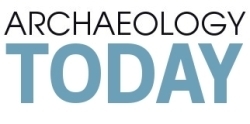
January 12th, 2014
Archaeologists Discover Rare Ancient Maya Mural in Belize
Known as Tulix Mul, it appears at first blush as a mound-like island of jumbled trees and bushes jutting out of a landscape that has been otherwise cleared by local mechanized ranchers for their cattle ranch operations. It is a curious protrusion, but only because this site holds special value to archaeologists and other researchers. The local landowner ranchers have agreed to leave it untouched — at least for now. Going forward, however, there are no guarantees. Development must ultimately meet the needs of developers. In the meantime, investigators are racing against the clock and other elements to excavate, study, and preserve the site. It is an ancient Early Classic (200-600 CE) Maya site in northwestern Belize that contains evidence of at least two standing vaulted rooms. (Popular Archaeology)
There She Blew! Volcanic Evidence Of The World’s First Map
A new study of volcanic rocks suggests that an ancient mural may indeed depict an erupting volcano, adding new weight to a theory that this image is a contender for the world’s oldest known landscape painting or map. The mural was found at a vast archaeological site in central Turkey known as Catalhoyuk. This Neolithic town goes back 9,000 years and was a huge settlement for a time when people were first transitioning from hunter-gatherer to agricultural societies. (NPR)
Searching for the Amazon’s Hidden Civilizations
Look around the Amazon rainforest today and it’s hard to imagine it filled with people. But in recent decades, archaeologists have started to find evidence that before Columbus’s arrival, the region was dotted with towns and perhaps even cities. The extent of human settlement in the Amazon remains hotly debated, partly because huge swaths of the 6-million-square-kilometer rainforest remain unstudied by archaeologists. Now, researchers have built a model predicting where signs of pre-Columbian agriculture are most likely to be found, a tool they hope will help guide future archaeological work in the region. (Science)
Rare Gaming Piece Found at Anglo-Saxon Royal Hall
University of Reading archaeologists have discovered an ancient and extremely rare Anglo-Saxon board gaming piece while excavating a royal complex at Lyminge, Kent. The piece would have been used for a game similar to that of backgammon or draughts. The Anglo-Saxon’s had a strong tradition of playing board games. Individual gaming pieces, and sometimes complete sets in burials of the period, have been discovered. However not only is the piece the first of this type to be found since the Victorian period, it is the first ever piece to be discovered in a ‘gaming’ setting, an Anglo-Saxon royal hall. (Past Horizons)
Mexican archaeologists pinpoint origin of Aztatlan ceramics
Archaeological finds in the southern part of the western state of Sinaloa suggest that the culture that developed in that region gave rise to the ceramics at the Aztatlan Complex, Mexico’s National Anthropology and History Institute, or INAH, said. (Global Post)
Mapping the Origins of Cholera
Working with a nearly 200-year-old sample of preserved intestine, researchers at McMaster University and the University of Sydney have traced the bacterium behind a global cholera pandemic that killed millions – a version of the same bug that continues to strike vulnerable populations in the world’s poorest regions. Using sophisticated techniques, the team has mapped the entire genome of the elusive 19th century bacterium. (Past Horizons)
How a hunch led Nepalese archaeologist Kosh Prasad Acharya to stunning claim on Buddha birth date
Two archaeologists had a hunch that the Buddha’s birthplace in southern Nepal held secrets that could transform how the world understood the emergence and spread of Buddhism. Their pursuit would eventually see them excavate the sacred site of Lumbini as monks prayed nearby, leading to the stunning claim that the Buddha was born in the sixth century BC, two centuries earlier than thought. (ArtDaily.org)
American team identifies tomb of obscure Egyptian king
A team of American archaeologists this week identified the tomb of a hitherto obscure Egyptian king, Sobekhotep I, believed to be the founder of the 13th Dynasty. The 60-ton pink quartzite sarcophagus was unearthed last year, but the University of Pennsylvania team only managed to decipher the royal inscription on the stone at the beginning of 2014. Little is known about the 13th Dynasty’s rulers. (The Times of Israel)
Remains of 2,000-year-old woman found under South Florida road
Archeologists say a significant prehistoric find was made outside a quiet Florida neighborhood just before Christmas: a woman’s remains perfectly preserved for 2,000 years. A few weeks ago as construction crews were digging a trench for a water main along a busy road, they made a fascinating find in Davie, Fla. “We uncovered the remains of an Indian woman,” said Bob Carr, director of Archaeological and Historical Conservancy. “Prehistoric dating back 2,000 years.” (Ksat.com)




